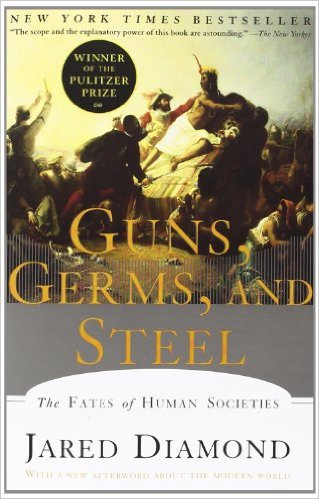For many years, I did not expect to like this book.
Jared Diamond has something of a reputation for primitivism—arguing that hunter-gatherer societies are actually better off than our own. I found this position abhorrent as an Objectivist and wanted to hear nothing of it.
Then, around a year ago, educational YouTuber C.G.P. Grey made a pair of videos* summarizing certain aspects of Diamond’s book. The theory, as presented there, made a lot of sense and piqued my interest. A few months later I purchased a copy of Guns, Germs, and Steel from my local Half Price Books and eventually got around to reading it.
It turned out to be really good.
First of all, Diamond’s position on agricultural civilization is much more considered than many give him credit for. In the course of his anthropological research he’s spent many months living with modern hunter-gatherer societies, experiencing that sort of existence first-hand. Diamond says that his “own impression, from having divided my life between United States cities and New Guinea villages, is that the so-called blessing of civilization are mixed.” He goes on to discuss the various benefits that extremely low-tech societies realize: better family ties, richer social life, and considerably more free time.
His argument, then, is less that industrial civilization is necessarily bad, so much as that it comes with trade-offs. These trade-offs were far more salient for pre-Renaissance agricultural societies, for whom producing enough food to survive took nearly all available resources, and which were subsequently ravaged by war, disease, and famine on a level which pre-agricultural peoples almost never experienced.
But if the hunter-gatherer lifestyle is so great, why didn’t it stick around? The answer is simple enough: agricultural societies out-competed them. Farming allows a much larger population to subsist on the same land, and additionally allows for the development of professions—specialists not directly involved with food production. With a few exceptions, agricultural societies assimilated, displaced, outbred, or simply exterminated their less advanced neighbors.
So why did certain agricultural societies get an upper hand on the others? This is the real question of Diamond’s book.
His answer comes down to one word: geography. The orientation of the continents, the climate at various locations, and similar factors dictated what early humans had available to work with. The Americas and Africa, on their North-South axes, were at a significant disadvantage compared to Eurasia’s East-West axis. Plants and animals spread over a much wider area, increasing the odds that a human population would have the opportunity to domesticate them.
Thus the Americas and Africa ended up with a much slower diffusion of agriculture. (Australia had it even worse.) While industrial civilization might have developed there, it would have been much later. Eurasian colonization cut such trajectories short.
Diamond rejects the notion that certain peoples’ inherent superiority was the fundamental driver of historical progress. Over the course of millennia, cultural and genetic mutation would have been sufficient to make such factors irrelevant. Societies which disregard the advantages of any particular technology don’t tend to stick around very long. Thus human cultures tend to be near the full potential set by their geographic conditions.
We can observe this through natural experiments, the colonization of Polynesia in the last 2,000 years being a prime example. Austronesians, expanding out of Formosa, landed on nearly every Pacific island, and settled pretty much any scrap of land that can support human populations. These ranged from proto-empires in Hawaii and Fiji, to hunter-gatherers on the cold southern Chathams, which were conquered by New Zealand Maoris wielding European firearms in 1835. It also includes tiny Anuta, which despite a population of less than 200 realized an extremely high population density through advanced agriculture.
In a similar manner, Diamond explores the development of African, American Australian, Chinese, and European cultures in the context of geographic determinism. Of particular note is the impact of states on technology. China, a single political unit, abandoned oceanic exploration due to internal factionalism, and never expended the capital costs necessary to resume. Europe, alternatively, was never truly unified, and so never stopped exploration altogether.
Several chapters are devoted specifically to literacy, technology, and political theory. I think a few of my libertarian friends would find them quite interesting, particularly those concerned with what a stateless society might look like. Also noteworthy are the discussions of cultures which had and lost technology—writing being one example, Roman concrete being another. This obviously does not read as a conservative book, but the more intellectual breed of rightists will find something worth considering in Part Three.
Altogether, I found Diamond’s theory intelligent and well-argued. He does not pretend that it’s perfect. His epilogue is an exhortation for more serious study—history as a science, as he call it. Nearly thirty pages are devoted to suggested further readings. Find a copy, apply a light dose of skepticism, and enjoy.

*The first of these is Americapox: The Missing Plague, which discusses why European diseases were so devastating to Native Americans, but not vice versa. The second is Zebras vs Horses: Animal Domestication, which digs deeper into the causes at play. Disease is only one of the proximate factors Diamond discusses, and I’ve mostly chosen to omit it from my review because Grey explains far better than I could.
